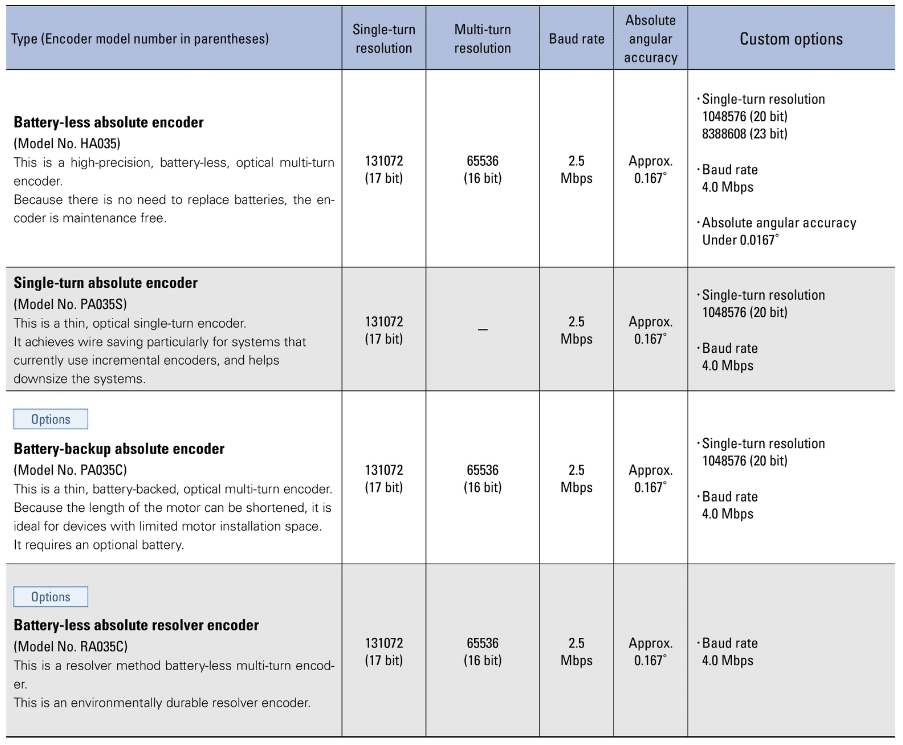We offer various encoders that help to select the best encoder for your servo motor.

Choosing single-turn or multi-turn absolute encoders for your servo motors
Incremental versus absolute encoders
Incremental and absolute encoders have similarities but differ in wiring and movement identification. An incremental encoder only reads pulses to provide information about the relative motion of the shaft. It has no information about location when powered up because it can only show how far it has moved since being powered up. It reports back these position changes with electrical pulses. These pulse streams can either be single channel (one output wire from the encoder) or dual channel (two wires).
An incremental encoder is akin to a tape measure with no numbers on it, only tick marks. Such a device would indicate how far something has moved, but not its initial position.
By contrast, a single-turn, rotary, absolute encoder can report back exactly what angle it’s at even when first powered up. These encoders are typically used for applications in industrial control and robotics that cannot quickly or easily perform a homing sequence. An absolute encoder is like a compass in that its exact position is shown as soon as it’s viewed.(1)
Calculating Encoder Resolution
Rotary absolute encoder resolution is measured in positions per revolution. The rotary encoders are comprised of an internal coded disc and a sensing head used to determine rotary position.
Resolution for absolute encoders is defined as the number of positions per revolution as the disk rotates through 360°. Sometimes the equivalent term codes per revolution is used.(2)
In our encoder table you can see the resolution of the absolute encoders is specified in bits. The disk used in the encoder has 17-bit resolution with one bit being produced from each of the 17 tracks at each position. The resolution in bits is 131,072 positions per revolution.
Single- vs. Multi-Turn Encoders
Single-turn absolute encoders are designed to be wired to general-purpose industrial automation I/O. There’s a drawback to single-turn absolute encoders: the exact angle of the encoder when powered up is evident, but the number of turns made before powering up isn’t. Multi-turn absolute encoders are used to solve this problem.
Multi-turn absolute encoders usually have a battery or super-capacitor that monitors how many revolutions the encoder has turned even while power is off. A multi-turn absolute encoder is similar to a measuring wheel that increments once per revolution. (1) The encoders communicate with our servo amplifiers that have special receivers on board to decode their position information.
Development of the Battery-less Absolute Encoder for Maintenance-free Operation
The high-precision battery-less absolute encoder Model No. HA035 is available as a standard option for SANMOTION servo motors. It does not require a battery or a periodic replacement part, so the need for cumbersome maintenance and export procedures is eliminated.
The “HA035” that we have developed is a small, high accuracy, battery-less absolute encoder that can be installed on our R series servo motors with a flange size of 40 mm or more and is being presented as the new standard encoder to replace the “PA035”. The “HA035” has an absolute angular accuracy of 1 arc-minute and a maximum resolution of 23 bits, making it more accurate with higher resolution than conventional models. Moreover, it also has improved environmental resistance, with a maximum working temperature of 105˚C and vibration resistance of 15 G.
To learn more about the development and the new features of our latest absolute encoder, read our post, “Cut Downtime Maintenance with The HA035 Batteryless Encoder“

[…] backup. There are multiple encoder choices available. Each encoder description is available for review in our encoder post and within the core […]
[…] A servo system requires an amplification of its error signals from the servo motor’s encoder. This amplification is called the servo amplifier or servo drive. When a servo motor is […]
[…] Selecting Encoders for your SANMOTION Servo Motor […]